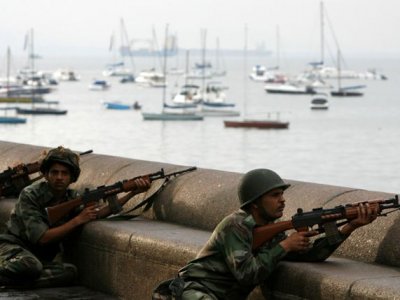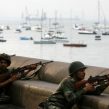
Combating Terrorism in Asian Waters
Publication: Terrorism Monitor Volume: 7 Issue: 35
By:

Last year’s devastating attack on Mumbai by operatives of Lashkar-e-Taiba (LeT) was a reminder of the importance of securing the maritime environment against terrorist activities. It was not the first time terrorists had exploited weaknesses in marine security in Asia, but it drew attention to the necessity of securing national coastlines, a challenging task for the developing naval forces of many Asian nations.
The “Mumbai Dossier” prepared by Indian government agencies through the interrogation of Muhammad Ajmal Amir (a.ka. Kasab—the only terrorist captured alive in the attack) and other material evidence provides a clear and coherent picture of the sequence of the attack, including its planning and preparation (Hindu.com, January 5). According to the dossier, ten terrorists departed Karachi in Pakistan for Mumbai onboard the fishing vessel Al-Husseini. En route they hijacked the Indian fishing craft Kuber, killed the crew and threw their bodies overboard. Afterwards they abandoned the fishing vessel and shifted to inflatable craft that landed at unsecured waterfronts in Mumbai. The perpetrators were highly motivated, well trained and proficient in use of GPS (global positioning systems). During the attack, the terrorists were in constant communication with their masters in Pakistan through satellite telephones.
Terrorist Groups in Asia with Maritime Capability
Besides Lashkar-e-Taiba (LeT), a number of terrorist groups in Asia are capable of using the maritime medium to conduct attacks:
• Liberation Tigers of Tamil Eelam (LTTE). Before their recent defeat by the Sri Lankan military, the LTTE had successfully exercised control of the seas off Jaffna in the northeast region of Sri Lanka. The movement’s naval wing, the Sea Tigers, were proficient in wolf-pack tactics using fast speed boats, underwater operations involving saboteur attacks and daring forays against the Sri Lankan Navy.[1] The group was also known to own and operate a fleet of ocean-going vessels that facilitated LTTE’s weapons and logistics supply chains. Besides already providing a major source of revenue, these vessels were also engaged in drug smuggling.
• Al-Qaeda is known to possess some naval capability. Abd al-Rahim al-Nashiri (captured in 2002 and currently held in Guantanamo Bay) was al-Qaeda’s naval specialist who designed assaults on shipping and underwater attacks by suicide demolition teams. In fact, al-Nashiri was the mastermind of the USS Cole and MV Limburg attacks in 2002. He devised a sophisticated naval strategy against shipping that recommended ramming merchant ships with motorized swimmer delivery vehicles carrying explosives, planting explosives on ships in port and carrying out underwater attacks by divers (Asia Times, May 11, 2007).
• Jemmiah Islamiah (JI) in Indonesia. The JI has contacts with al-Qaeda and may have been trained in maritime attacks and suicide scuba diving. In 2003, Singapore authorities foiled JI plans to attack U.S. naval vessels in the Changi Naval base. The JI operatives had meticulously drawn up plans and identified “kill zones” to conduct suicide boat attacks on vessels in the narrowest part of the channel. [2]
• Harkat-ul-Jihad-al-Islami (HuJI). The Bangladesh-based HuJI is believed to be an offshoot of a group based in Pakistan with links to Osama bin Laden and has a force of about 15,000 operatives (Satp.org, November 12). HuJI is also intricately linked to insurgent groups in northeast India and has been a major source of weapons in this area for a long time (Indian Express, August 17). Huge consignments of illegal arms sourced in Southeast Asia are moved across the seas by HuJI and unloaded in Bangladeshi ports before being sold to Indian insurgent groups. [3]
• The Moro Islamic Liberation Front (MILF) and Abu Sayyaf Group (ASG) in the Philippines. The MILF has been active in waters around the Philippines and has a limited maritime capability. In 1999, the group is alleged to have approached North Korea for a mini-submarine, though a MILF spokesman said the report was “absolutely untrue” (Reuters, January 4, 2005). The ASG has significant maritime capability built around stealthy, high speed, shallow-draft wooden boats that are equipped with machine guns. The group was responsible for the February 2004 bombing of Super Ferry 14 90 minutes out of Manila Bay that killed over 100 people (Asia Times, April 24, 2004).
It is evident that some terrorist groups in Asia possess significant maritime capability, or at least the ability to strike targets on or from the sea. In the past, they have successfully employed sophisticated tactics and recorded spectacular attacks against ships and coastal infrastructure. The ability to mount attacks through the subsurface medium using mini-submarines, submersible platforms, sea mines (Limpet mines) and saboteurs are sought after and at least one group (the LTTE) had gained some proficiency in these methods.
Complexity of the Maritime Domain
The sea offers both opportunities and challenges. It is an open highway and nearly 90 percent of global trade is carried onboard commercial ships, making the sea lanes the umbilical cord of the global economy. At another level, the sea can be perilous; it is vast, opaque and provides an excellent means to engage in terrorism “at sea,” as demonstrated by the USS Cole and MV Limburg attacks, and “from the sea,” as witnessed by the 2008 Mumbai attacks.
Although the sea is a complex medium and requires greater skills to conduct attacks, it is becoming popular among terrorist groups partly due to the success of maritime attacks mounted so far. Significantly, a variety of equipment found in the inventory of terrorist groups (high speed recreational boats, sea scooters, scuba diving equipment, etc.) are of dual nature and are relatively easy to acquire commercially without inviting suspicion. The innovative use of these tools by the terrorist groups has overwhelmed Asia’s maritime security agencies.
Responding to Maritime Terrorism
Several Asian navies have modified their strategies and doctrines to address threats arising from asymmetric actors. There is an ongoing transformation in the naval force structure built around highly agile platforms like smaller boats that can be quickly deployed for a wide spectrum of low-end missions to engage a sophisticated enemy operating on the high seas. Distinctive assets are provided by air platforms for surveillance and reconnaissance. These are both manned (fixed wing aircraft and helicopters) and unmanned (unmanned aerial vehicles, aerostats and satellites) and are highly networked with a variety of sea-based platforms. In essence, Asia’s navies are building capabilities to obtain credible maritime domain awareness.
At another level, several multilateral, trilateral and bilateral forums have mushroomed in Asia, where countries must address maritime asymmetric threats and challenges. These include the East Asia Summit (EAS), ASEAN Regional Forum (ARF), Indian Ocean Naval Symposium (IONS), and Track II initiatives such as the Council for Security Cooperation in the Asia Pacific (CSCAP). The Regional Cooperation Agreement on Combating Piracy and Armed Robbery against Ships in Asia (ReCAAP) is a significant government-to-government agreement by fourteen Asian countries to enhance the security of regional waters.
At the functional-operational level, Asian countries are engaged in bilateral and multilateral naval exercises focused on terrorism and piracy, intelligence sharing arrangements, symposiums, conferences and training arrangements. The Malaysia-Singapore-Indonesia (MALSINDO) trilateral naval patrols and the Eyes in the Sky (EIS) air patrol involving maritime aircraft from Malaysia, Singapore, Indonesia and Thailand are significant regional initiatives aimed at enhancing security of the Straits of Malacca.
The Asian nations have also undertaken capacity building initiatives that involve the training of personnel, financial assistance, technology support and even maritime surveillance assistance. For instance, Japan and India have committed financial assistance and China has provided technological support for the security and safety of the Straits of Malacca. [4] The United States has supplied radars to Indonesia for maritime surveillance and Japan has transferred small ships to Malaysia and Indonesia to bolster their patrolling capability. [5] India also provides maritime surveillance cover to the Maldives. (Times of India, October 17)
Some Asian countries are ill-equipped to guarantee maritime domain awareness since there are critical weaknesses and deficiencies in their monitoring and surveillance. Furthermore, they are overwhelmed by the responsibility of monitoring vast littoral territories. In the absence of technological wherewithal, they remain vulnerable while their coasts emerge as hotbeds of illegal activity that provide a breeding ground and launching point for terrorist activities. At the operational level, the absence of “hot pursuit” agreements is dexterously exploited by terrorists, insurgents, pirates and other criminals to evade capture. Many Asian states have yet to develop a common legal framework to prosecute terrorists, partly due to varying domestic perceptions and humanitarian laws.
Conclusion
It is evident that maritime asymmetric challenges and threats require a sophisticated strategy that pivots on domain awareness, an effective intelligence apparatus, and a credible armed response. So far Asian nations have done well by building capacities to respond to maritime terrorism, but further incidents like the 2008 Mumbai attack still remain a possibility. At one level, this is due to the covert nexus between states and terrorist groups in which some states may employ terrorism as a policy against their adversaries. At another level, it could be due to poor governance of sea spaces resulting in “chaos in the littorals,” particularly in Bangladesh, Indonesia and the Philippines.
Robust maritime domain awareness still eludes Asian countries due to financial and technological deficiencies. This situation has the potential to adversely impact the security of the entire region. There will be added pressures on Asian nations to build response capabilities to preclude intervention by other stakeholders, including extra-regional powers who could try to exploit the security vacuum as a means of establishing a wide naval presence in Asian waters.
Notes:
1. Vijay Sakhuja, “The Dynamics of LTTE’s Commercial Infrastructure”, Observer Research Foundation Occasional Paper, April 2006.
2. The Jemaah Islamiyah Arrests and the Threat of Terrorism,” White Paper, Ministry of Home Affairs, Republic of Singapore, 2003.
3. Anthony Davis, ‘New Details Emerge on Bangladesh Arm’s Haul’, Jane’s Intelligence Review, September 2004.
4. Hasjim Djalal, “The Development of Cooperation on the Straits of Malacca and Singapore,” Paper presented at the International Symposium on Safety and Protection of the Marine Environment in the Straits of Malacca and Singapore, Kuala Lumpur, November 24, 2008.
5. John B. Haseman and Eduardo Lachica, “Getting Indonesia Right”, Joint Forces Quarterly, Issue 54, 2009.





